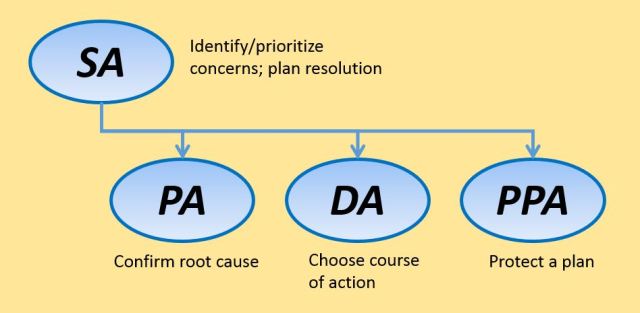Last week I was asked what I do for a living. Rather than give a long explanation concerning Decision Management and Systems Engineering consulting, I went with the short version, “I teach people how to think” and followed it tongue-in-cheek with “It’s a tough job, but someone has to do it!”.
Actually, its a great job, a blessed privilege, lots of fun and the ticket to continuous learning on my part.
That exchange reminded me that I’ve been consulting for over 30 years; half a life and three/fourths of a career. Thirty years ago, I was immersed in the roll-out of Kepner-Tregoe (K-T) Problem-Solving/Decision-Making (PSDM) workshops/skills at a large defense contractor (since renamed/resold/merged multiple times). I had been exposed to the K-T Rational Processes early in my career, used them extensively as an individual in my first engineering job and had gained a reasonable mastery of the basic human thinking skills that they represent. My passion for systematic thinking convinced my new boss (Director of Manufacturing Engineering) that such skills could make a difference in his workforce of 300 engineers and technicians.
If you’re unfamiliar with K-T precepts, I’ll summarize:
- There are four fundamental thinking patterns/processes (SA: Situation Appraisal, PA: Problem Analysis, DA: Decision Analysis and PPA: Potential Problem Analysis) by which knowledge workers successfully address their job concerns.
- These patterns are not theoretical; they were discerned by observation across many industries and job roles.
- Mastery of these systematic thinking building blocks can greatly improve the effectiveness and efficiency of individuals and teams in any work situation.
- The ability to do great thinking is a skill that can be taught.

In March of 1986 I attended a 12-day PSDM Bootcamp that deepened my understanding of these processes and how to communicate such skills to my peers. In May, 1986 I taught my first PSDM workshop to the Manufacturing Engineering management team. By the fall of 1986 I was teaching 2 workshops a month, coaching my students in the use of their new skills on the job and helping to build systematic thinking techniques into the company’s business and engineering processes. A consultant was born!
The K-T framework is essentially a set of questions that frames the issues/concerns in any situation and creates an efficient “knowledge pull” from the stakeholders and contributors. Because it’s independent of any type of business or technology domain (and works just as well in our personal lives), this also implies there is a universal information architecture for human thinking. That leads the possibility of knowledge patterns and software tools that expose these patterns. Most of what I’ve done in the Systems Engineering and Decision Management fields is simply the refinement of these patterns and tools, accelerated by the rapid learning cycles that come from seeing any situation as some combination of SA, PA, DA and PPA.
From K-T I also learned how to avoid lot of bad thinking habits:
- Failure to separate concerns
- Diving into detail
- Jumping to cause
- Jumping to an alternative
In three decades of business, engineering and innovation consulting, I’ve seen my share of movements, frameworks and methodologies (TQM, CMMI, Six Sigma, Lean, Agile, MBSE, Business Model Canvas, …). All of these promote useful concepts; but none of them simplified my world as much as the four elegant K-T Rational Processes that lay a foundation for great thinking in any situation. Many of the proponents of these frameworks seem to exhibit the bad thinking habits that I learned to avoid.
What’s been your experience?
